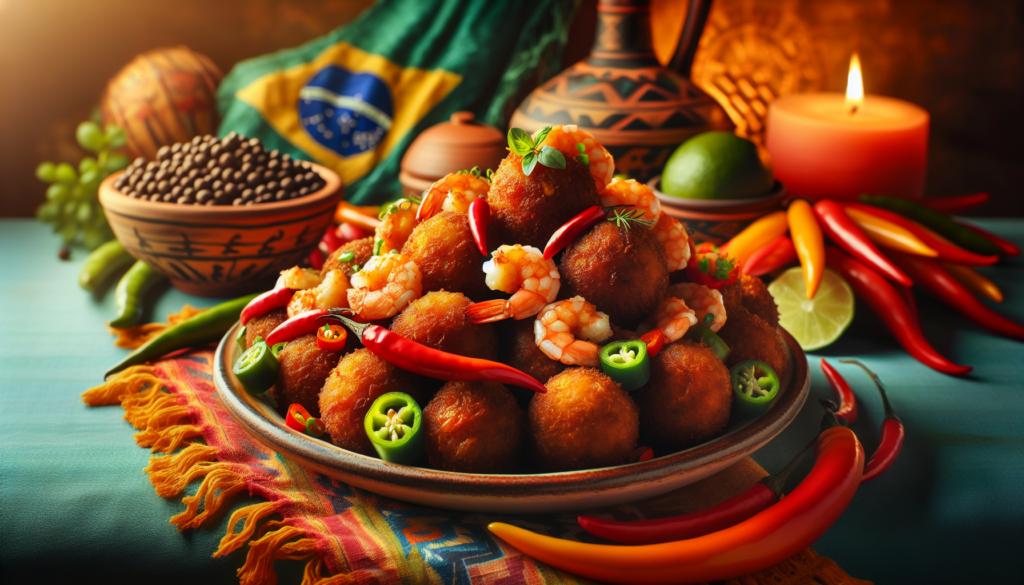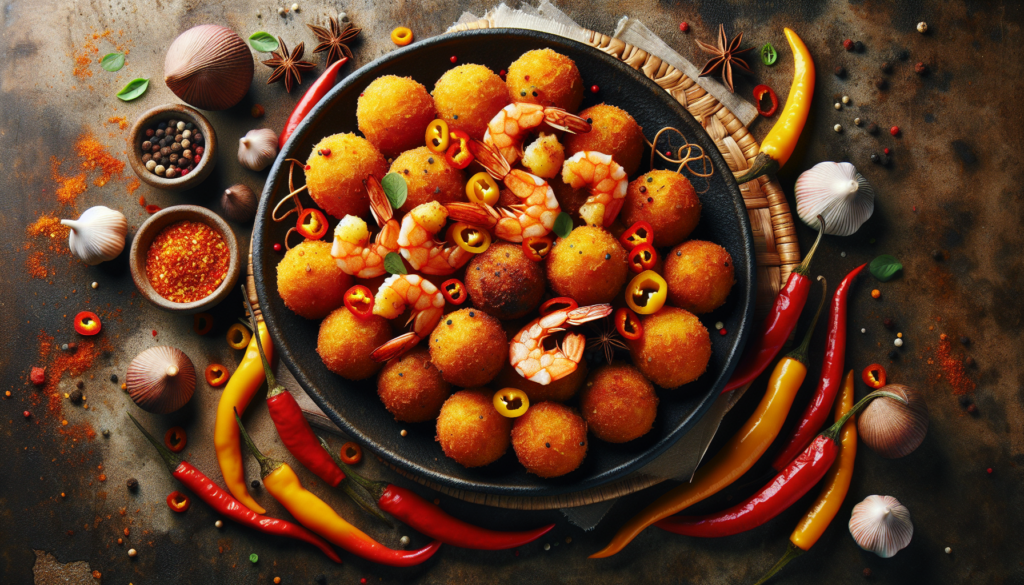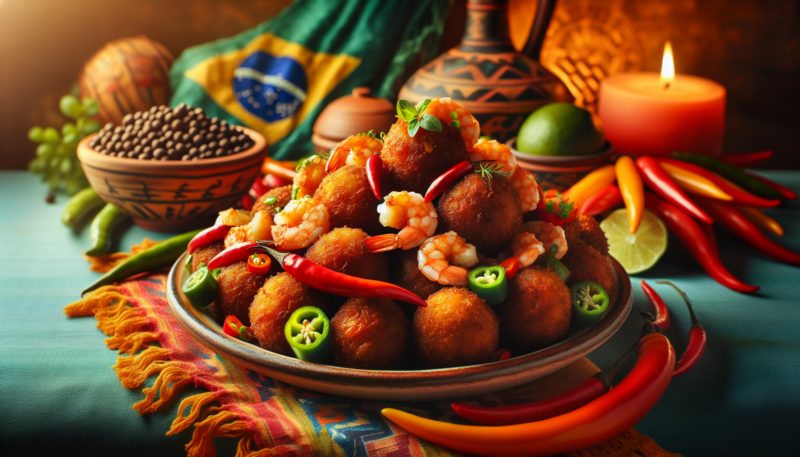Imagine stepping into the vibrant streets of Brazil, where the air is filled with the tempting aroma of sizzling spices and mouthwatering flavors. If you’re a lover of exotic cuisines, then you simply can’t miss out on the delectable Brazilian Acarajé. The combination of crispy deep-fried dough, stuffed with a savory mixture of shrimp, onions, and spices, is a culinary delight that will transport your taste buds straight to the beaches of Bahia. In this article, we will guide you through the process of creating this traditional Brazilian dish, so get ready to embark on a culinary adventure like no other.
Ingredients
To make a delicious Brazilian acarajé, you will need the following ingredients:
Dried black-eyed peas
These peas are the base of the acarajé and provide a rich, nutty flavor.
Onion
Onions add a subtle sweetness and depth of flavor to the acarajé mixture.
Fresh green or red chili pepper
Chili peppers provide a spicy kick to the acarajé and add a vibrant touch to the overall taste.
Salt
Salt is essential for seasoning the acarajé mixture and enhancing the flavors of the other ingredients.
Palm oil
Palm oil is traditionally used for frying the acarajé and adds a unique flavor and beautiful golden color to the dish.
Dried shrimp
Dried shrimp contribute a delicious umami flavor to the acarajé filling.
Ground dried shrimp
Ground dried shrimp adds an extra layer of flavor and texture to the acarajé mixture.
Garlic cloves
Garlic enhances the overall taste of the acarajé and gives it a delightful aromatic quality.
Ground red pepper
Ground red pepper adds a touch of heat to the acarajé, balancing out the flavors.
Cilantro
Cilantro adds a fresh and herbal taste, brightening up the dish.
Lime wedges
Lime wedges are traditionally served alongside acarajé, providing a tangy and refreshing element to the dish.
Preparation
To make acarajé, you will go through several preparation steps, including soaking and peeling the black-eyed peas, blending the mixture, seasoning, shaping, frying, preparing the filling, and assembling the acarajé.
Step 1: Soaking and peeling the black-eyed peas
Start by soaking the black-eyed peas overnight in water. This softens them and makes them easier to peel. After soaking, remove the skins by rubbing the peas between your hands or using a cloth to gently separate the skins from the peas. Rinse the peeled peas thoroughly.
Step 2: Blending the black-eyed peas
In a food processor or blender, blend the peeled black-eyed peas until they form a smooth and thick paste. You may need to add a small amount of water to achieve the right consistency.
Step 3: Seasoning the black-eyed pea mixture
In a large bowl, combine the blended black-eyed pea mixture with diced onions, chopped chili peppers, salt, dried shrimp, ground dried shrimp, minced garlic cloves, ground red pepper, and finely chopped cilantro. Mix well to incorporate all the flavors.
Step 4: Shaping the acarajé
Take about two tablespoons of the seasoned black-eyed pea mixture and shape it into a small patty or ball. Use wet hands to prevent the mixture from sticking. Repeat this process until all the mixture is used.
Step 5: Frying the acarajé
In a deep pan or pot, heat the palm oil over medium-high heat. Once the oil is hot, carefully add the shaped black-eyed pea patties or balls and fry them until they turn golden brown and crispy. Make sure to flip them to ensure even frying. Remove the fried acarajé from the oil and place them on a paper towel-lined plate to drain excess oil.
Step 6: Preparing the filling
Traditionally, acarajé is filled with a flavorful mixture of vatapá, caruru, and other ingredients. Vatapá is a rich and creamy paste made from bread, shrimp, coconut milk, peanuts, and spices, while caruru is a okra stew made with shrimp, palm oil, and spices. These fillings complement the crunchy acarajé perfectly. However, you can also get creative and use different fillings according to your taste preferences.
Step 7: Assembling the acarajé
To assemble the acarajé, carefully split open the fried and crispy acarajé balls, creating a pocket for the filling. Fill it generously with the prepared filling and top with additional cilantro, lime wedges, or any other desired accompaniments.

Tips and Variations
While the traditional acarajé recipe is delicious on its own, you can also try out some variations to add your own personal touch. Here are a few ideas:
Using fresh or canned black-eyed peas
If you don’t have dried black-eyed peas or prefer a convenient option, you can use fresh or canned black-eyed peas instead. Just make sure to adjust the soaking and cooking time accordingly.
Adding other vegetables to the filling
Feel free to experiment with additional vegetables in the filling, such as bell peppers, tomatoes, or corn. These additions can enhance the flavor and add more texture to the acarajé.
Substituting palm oil with other oils
If you can’t find palm oil or prefer a different oil, you can use vegetable oil, sunflower oil, or any other oil with a high smoke point for frying the acarajé. However, keep in mind that palm oil does contribute to the traditional flavor and color of the dish.
Serving suggestions
Acarajé is often enjoyed on its own as a street food snack, but you can also serve it as part of a meal. Accompany it with traditional Brazilian sides like rice, beans, and farofa for a complete and satisfying meal.
Health Benefits
While acarajé is a delicious treat, it also offers some health benefits due to its nutritious ingredients.
Protein-rich black-eyed peas
Black-eyed peas are a great source of plant-based protein, making acarajé a filling and satisfying dish. Protein is essential for maintaining and repairing body tissues, supporting immune function, and promoting muscle growth.
Antioxidants from palm oil
Palm oil contains a high amount of antioxidants, such as carotenoids and tocopherols, which help protect the body against oxidative stress and reduce the risk of chronic diseases.
Culinary uses of dried shrimp
Dried shrimp, a key ingredient in acarajé, are an excellent source of protein, omega-3 fatty acids, vitamins, and minerals. Apart from their nutritional value, they also add a unique umami flavor to the dish.

Cultural Significance
Acarajé holds great cultural significance in Brazil, particularly in the northeastern region of the country. Let’s explore its origins, traditional street food status, and its role in religious ceremonies.
Origins of acarajé
Acarajé traces its roots back to the West African country of Nigeria, where it was part of the traditional diet of the Yoruba people. When enslaved Africans were brought to Brazil during the colonial era, they brought their culinary traditions with them, including the art of making acarajé.
Acarajé as a traditional street food
Today, acarajé has become an emblematic street food in Brazil, especially in the state of Bahia. Street vendors, known as baianas, can be found all over the streets, selling freshly fried acarajé stuffed with flavorful fillings.
Acarajé in religious ceremonies
In addition to being a beloved street food, acarajé also plays an important role in Afro-Brazilian religious ceremonies, particularly in Candomblé. It is often offered as a sacred food to the deities, representing a connection between the spiritual and physical world.
Similar Brazilian Dishes
Brazil has a rich culinary heritage, and acarajé is just one of many delicious dishes from this vibrant cuisine. Here are some other popular Brazilian dishes you might enjoy:
Moqueca
Moqueca is a fragrant and flavorful fish stew made with coconut milk, tomatoes, onions, garlic, and various spices. It is typically cooked in a clay pot and is a beloved dish along the Brazilian coastal regions.
Feijoada
Feijoada is Brazil’s national dish, consisting of a hearty black bean stew cooked with different cuts of pork, such as bacon, sausages, and various smoked meats. It is often served with rice, collard greens, and orange slices.
Pão de Queijo
Pão de Queijo, also known as cheese bread, is a popular Brazilian snack made with tapioca flour and cheese. These small, fluffy, and cheesy rolls are perfect for breakfast, as a snack, or served alongside other dishes.
Coxinha
Coxinha is a savory pastry that features a creamy, shredded chicken filling wrapped in a dough made from wheat flour and mashed potatoes. These teardrop-shaped delights are deep-fried to perfection, creating a crispy exterior and a soft, flavorful interior.
Brigadeiro
Brigadeiro is a beloved Brazilian sweet treat made from condensed milk, cocoa powder, butter, and chocolate sprinkles. These bite-sized balls of chocolatey goodness are a staple at birthday parties and celebrations.
Traditional Accompaniments and Beverages
To complete your Brazilian culinary experience, consider serving some traditional accompaniments and beverages alongside your acarajé.
Vatapá
As mentioned earlier, vatapá is a creamy and flavorful paste made from bread, shrimp, coconut milk, peanuts, and spices. It is traditionally used as a filling for acarajé but can also be enjoyed as a side dish or spread on bread.
Caruru
Caruru is a traditional okra stew made with shrimp, palm oil, ground peanuts, and spices. It is often served alongside acarajé and complements the flavors of the dish beautifully.
Farofa
Farofa is a toasted cassava or cornmeal mixture that adds a crunchy and flavorful element to many Brazilian dishes. It can be seasoned with ingredients like onions, bacon, parsley, or dried shrimp.
Cachaça
Cachaça is a Brazilian distilled spirit made from sugarcane juice. It is the main ingredient in the classic Brazilian cocktail, caipirinha, and is also enjoyed on its own.
Caipirinha
Caipirinha is Brazil’s national cocktail, made with cachaça, fresh lime, sugar, and ice. This refreshing and tangy drink is perfect for sipping alongside your acarajé.
Popular Variations
While the traditional acarajé recipe is already fantastic, you can explore some popular variations to suit different dietary preferences and tastes:
Acarajé de Frango (Chicken Acarajé)
For a twist on the traditional recipe, you can make acarajé filled with a flavorful chicken filling. Cook and shred chicken breast, then season it with spices like paprika, cumin, and garlic powder. Fill the acarajé with the chicken and enjoy this meaty variation.
Acarajé Vegano (Vegan Acarajé)
To cater to vegan preferences, you can make a vegan version of acarajé by omitting the dried shrimp and using vegetable oil instead of palm oil for frying. Fill it with a variety of vegetables, such as sautéed mushrooms, diced bell peppers, and shredded carrots.
Acarajé de Camarão (Shrimp Acarajé)
If you simply can’t get enough of the flavor and texture of shrimp, you can make a shrimp-filled version of acarajé. Cook and season the shrimp with garlic, lime, and spices, then sauté them until they are plump and tender. Fill the acarajé with the shrimp and enjoy the deliciousness.
Acarajé de Queijo (Cheese Acarajé)
Cheese lovers will delight in a cheese-filled acarajé variation. Mix grated cheese, such as Brazilian queijo coalho or feta cheese, into the acarajé mixture before frying. The cheese will melt and create a gooey and savory filling within the crispy acarajé shell.
Where to Find Acarajé
If you’re eager to try authentic acarajé, you can find it in several places:
Street vendors in Brazil
Acarajé is most commonly sold by street vendors, known as baianas, in the streets of Brazil, particularly in the northeastern state of Bahia. Look for vendors in busy markets or areas with a vibrant street food culture to enjoy this delicious treat.
Brazilian restaurants worldwide
Brazilian restaurants, especially those specializing in regional cuisine, are likely to feature acarajé on their menus. If you’re outside of Brazil, look for Brazilian restaurants in your area to experience the flavors of this beloved dish.
Specialty food stores
Some specialty food stores may carry frozen or pre-made acarajé that you can enjoy at home. Check your local ethnic or Brazilian stores for these pre-packaged options.
In conclusion, acarajé is a delightful Brazilian dish that combines the flavors of black-eyed peas, spices, and fillings to create a crunchy and flavorful street food delicacy. Whether you choose to make it at home or seek it out in Brazil or beyond, acarajé is sure to satisfy your taste buds and transport you to the vibrant streets of Brazil. Enjoy this culinary masterpiece with friends and family, and savor the rich cultural heritage it represents.
